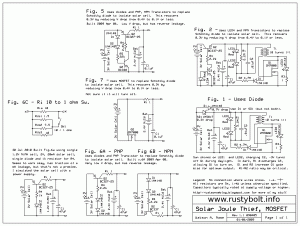 I did some experiments a few years ago with a photovoltaic solar cell charging 1 or 2 NiMH cells, and running a Joule Thief after dark. This is commonly known as a solar garden light. I tried to eliminate the drop across the isolation diode, which is about 1 volt for a 1N4148 or a half volt for a 1N5817 Schottky diode. My experiments were somewhat successful. I believe I wrote this up in my watsonseblog, but I haven’t been able to recover it. Click on the schematic a few times to enlarge it.
I did some experiments a few years ago with a photovoltaic solar cell charging 1 or 2 NiMH cells, and running a Joule Thief after dark. This is commonly known as a solar garden light. I tried to eliminate the drop across the isolation diode, which is about 1 volt for a 1N4148 or a half volt for a 1N5817 Schottky diode. My experiments were somewhat successful. I believe I wrote this up in my watsonseblog, but I haven’t been able to recover it. Click on the schematic a few times to enlarge it.
The 2N7000 MOSFET is fun to use in a Joule Thief, but requires 2 to 3 volts to turn on the gate, so it normally requires a 2 cell supply or about 2.4V. For a conventional JT, a single 1.2V cell will work okay, but don’t use a 2N3904 unless you want to have reduced light output; instead use a 2N4401 or PN2222A, or BC337-25.
At first I thought that I had drawn the red LEDs in Fig.1 with the wrong polarity. But then I read the note below, and remembered how they work. The red LEDs are exposed to the sunlight and act like micro solar cells; they generate a small current that puts a negative voltage on the 2N7000 gate, and keeps it turned off during the day. I used them similarly in the other schematics. A red LED is cheaper and easier to obtain than a CdS photocell, and with a transistor to boost the current, can do much of what a CdS photocell can do. Try it if you don’t believe me. It works.
Back to experimenting…